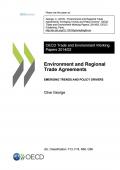
This report examines trends in the use of environmental provisions in Regional Trade Agreements and identifies factors which may explain the presence or absence of these provisions. The report builds on work of the OECD Joint Working Party on Trade and Environment (JWPTE) and includes results of an informal survey of delegates.
Analysis of the environmental provisions in RTAs reveals an encouraging upward trend. While basic provisions remain the most common types found in RTAs, the incidence of more substantive provisions has increased significantly in recent years. Among these, environmental co-operation has been the most common type.
Several factors may have contributed to this evolution. These include countries extending their political mandates for RTAs, for example to include provisions for compliance with multilateral environmental agreements (MEAs), as well as a general accumulation of experience with the use of environmental provisions.
The report includes case studies from Australia, Canada, Chile, the European Union, Japan, New Zealand, United States and Switzerland.
This report reviews the skills available and skills required for the introduction and deployment of green technologies in the steel industry in India. It reviews the existing systems in place for developing a skilled labour force and proposes some specific recommendations on how to adapt to evolving demands. The report provides evidence and new information to contribute to a tripartite dialogue on promoting access to skills for green jobs and the greening of existing jobs in the Indian steel sector to create decent, productive work and to improve the competitiveness and environmental sustainability of the industry.
This report reviews in a systematic manner the skills available and skills required for the introduction and deployment of green technologies in the cement industry in Indonesia. It reviews the existing systems in place for developing a skilled labour force and proposes some specific recommendations on how to adapt to evolving demands. This report builds on continuing efforts made by the International Labour Organization in reviewing the need for skills for green jobs and the development of sector-based analysis for advancing global research work on promoting decent work. The report provides evidence and additional new information to support a tripartite dialogue on the best approach for promoting access to skills for green jobs and the greening of existing jobs in the Indonesian cement industry to create decent, productive work and to improve the environmental sustainability and competitiveness of the sector.
This report highlights the major forces fostering the shift to a resource-efficient green economy in Europe, including the role of EU policies. Currently, the economic and technological changes leading towards green economy objectives across the EU economy are proceeding too slowly; what is required is a much bigger, deeper, and more permanent change in the EU economy and society to create both new opportunities and substitution processes across the economic structure.

Payments for Ecosystem Services (PES) describes the situation where the user of an environmental service, such as water purification, pays the landowners who provide that service. For PES to exist, there must be a clearly defined user and supplier, as well as a number of other necessary conditions, which are defined in this document using a summary of current sources. Particular attention is paid to how these conditions currently obtain within the UNECE region. The range of forest environment services is explored through fourteen detailed case studies, which examine best practice in promoting PES. Political and public relations implications of PES are discussed at length, and recommendations include the need for clarity about where PES may be a useful tool in moving towards a green economy and where other methods may be more appropriate.
